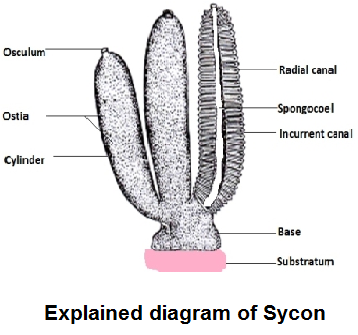Phylum Porifera













Phylum Porifera
Phylum Porifera: All sponges belong to this phylum. Sponges are aquatic animals which remain fixed to the bottom of the sea or some object. Such animals are called sessile. Most sponges are marine. Sponges can be of many shapes—round, sac like or branched. They are multicellular, but there is very little division of functions between the cells.
Therefore, the cells are not organized into tissues.These animals do not have a nervous system. A very special feature of sponges is the circulation of water throughout their body cavity which is called the spongocoel. Water, carrying nutrients and oxygen, enters through pores, called ostia, all over the body. It circulates in the body cavity and leaves it through a large pore called the osculum. This is the way a sponge feeds. They have a hard outer layer, or skeleton. The skeleton of sponges is formed of needle-like structures called spicules. One class of sponges called chalk sponges has calcerous made of calcium carbonate) spicules. In glass sponges the spicules are siliceous (made of silica) and in horny sponges the spicules are of spongin fibre (proteinaceous).
Examples : Sycon( Scypha), Sopngilla(fresh water sponge), Euspongia(bath sponge), Euplectella aspergillum(Venus flower basket).

The canal system is a that characteristic feature of _____________________ | |||
| Right Option : D | |||
| View Explanation | |||
Which is the only phylum in the animal kingdom without any nerve cell? | |||
| Right Option : A | |||
| View Explanation | |||
Which is the only phyllum without any nerve cell in the animal kingdom? | |||
| Right Option : A | |||
| View Explanation | |||
Students / Parents Reviews [10]
My experience was very good with Abhyas academy. I am studying here from 6th class and I am satisfied by its results in my life. I improved a lot here ahead of school syllabus.

Ayan Ghosh
8thAbhyas Methodology is very good. It is based on according to student and each child manages accordingly to its properly. Methodology has improved the abilities of students to shine them in future.

Manish Kumar
10thIt has a great methodology. Students here can get analysis to their test quickly.We can learn easily through PPTs and the testing methods are good. We know that where we have to practice

Barkha Arora
10thA marvelous experience with Abhyas. I am glad to share that my ward has achieved more than enough at the Ambala ABHYAS centre. Years have passed on and more and more he has gained. May the centre flourish and develop day by day by the grace of God.

Archit Segal
7thAbhyas is a complete education Institute. Here extreme care is taken by teacher with the help of regular exam. Extra classes also conducted by the institute, if the student is weak.

Om Umang
10thIt was a good experience with Abhyas Academy. I even faced problems in starting but slowly and steadily overcomed. Especially reasoning classes helped me a lot.

Cheshta
10thMy experience with Abhyas is very good. I have learnt many things here like vedic maths and reasoning also. Teachers here first take our doubts and then there are assignments to verify our weak points.

Shivam Rana
7thOne of the best institutes to develope a child interest in studies.Provides SST and English knowledge also unlike other institutes. Teachers are co operative and friendly online tests andPPT develope practical knowledge also.

Aman Kumar Shrivastava
10thI have spent a wonderful time in Abhyas academy. It has made my reasoning more apt, English more stronger and Maths an interesting subject for me. It has given me a habbit of self studying

Yatharthi Sharma
10thAbout Abhyas metholodology the teachers are very nice and hardworking toward students.The Centre Head Mrs Anu Sethi is also a brilliant teacher.Abhyas has taught me how to overcome problems and has always taken my doubts and suppoeted me.
